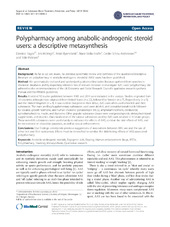| dc.contributor.author | Sagoe, Dominic | |
| dc.contributor.author | McVeigh, Jim | |
| dc.contributor.author | Bjørnebekk, Astrid | |
| dc.contributor.author | Essilfie, Marie-Stella | |
| dc.contributor.author | Andreassen, Cecilie Schou | |
| dc.contributor.author | Pallesen, Ståle | |
| dc.date.accessioned | 2015-12-10T12:26:23Z | |
| dc.date.available | 2015-12-10T12:26:23Z | |
| dc.date.issued | 2015-03-15 | |
| dc.Published | Substance Abuse Treatment, Prevention, and Policy 2015, 10:12 | eng |
| dc.identifier.issn | 1747-597X | |
| dc.identifier.uri | https://hdl.handle.net/1956/10735 | |
| dc.description.abstract | Background As far as we are aware, no previous systematic review and synthesis of the qualitative/descriptive literature on polypharmacy in anabolic-androgenic steroid(s) (AAS) users has been published. Method We systematically reviewed and synthesized qualitative/descriptive literature gathered from searches in electronic databases and by inspecting reference lists of relevant literature to investigate AAS users’ polypharmacy. We adhered to the recommendations of the UK Economic and Social Research Council’s qualitative research synthesis manual and the PRISMA guidelines. Results A total of 50 studies published between 1985 and 2014 were included in the analysis. Studies originated from 10 countries although most originated from United States (n = 22), followed by Sweden (n = 7), England only (n = 5), and the United Kingdom (n = 4). It was evident that prior to their debut, AAS users often used other licit and illicit substances. The main ancillary/supplementary substances used were alcohol, and cannabis/cannabinoids followed by cocaine, growth hormone, and human chorionic gonadotropin (hCG), amphetamine/meth, clenbuterol, ephedra/ephedrine, insulin, and thyroxine. Other popular substance classes were analgesics/opioids, dietary/nutritional supplements, and diuretics. Our classification of the various substances used by AAS users resulted in 13 main groups. These non-AAS substances were used mainly to enhance the effects of AAS, combat the side effects of AAS, and for recreational or relaxation purposes, as well as sexual enhancement. Conclusions Our findings corroborate previous suggestions of associations between AAS use and the use of other licit and illicit substances. Efforts must be intensified to combat the debilitating effects of AAS-associated polypharmacy. | en_US |
| dc.language.iso | eng | eng |
| dc.publisher | BioMed Central | eng |
| dc.rights | Attribution CC BY | eng |
| dc.rights.uri | http://creativecommons.org/licenses/by/4.0 | eng |
| dc.subject | Anabolic-androgenic steroids | eng |
| dc.subject | Ergogenic aids | eng |
| dc.subject | Doping | eng |
| dc.title | Polypharmacy among anabolic-androgenic steroid users: A descriptive metasynthesis | eng |
| dc.type | Peer reviewed | |
| dc.type | Journal article | |
| dc.date.updated | 2015-11-06T07:48:58Z | |
| dc.description.version | publishedVersion | |
| dc.rights.holder | Copyright Sagoe et al.; licensee BioMed Central. 2015 | eng |
| dc.identifier.doi | https://doi.org/10.1186/s13011-015-0006-5 | |
| dc.identifier.cristin | 1252751 | |
| dc.subject.nsi | VDP::Medisinske Fag: 700 | |
| dc.subject.nsi | VDP::Medisinske fag: 700::Helsefag: 800::Epidemiologi medisinsk og odontologisk statistikk: 803 | |
| dc.subject.nsi | VDP::Midical sciences: 700::Health sciences: 800::Epidemiology, medical and dental statistics: 803 | |

